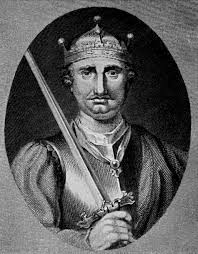Prince Philip has just died, a central part of the British monarchy for almost the last seventy-five years. The modern British monarchy has retained many aspects of the medieval monarchy, and Philip is an indication of how much is different and yet the same.
There was only one medieval English ruling queen with a husband who was decidedly not the king, and that was Mathilda. It shows how unusual Queen Elizabeth II is, Philip's widowed queen, that Mathilda doesn't even make it into the official list of kings and queens of England. She was the only legitimate surviving offspring of King Henry I of England, and when he died in 1135 he designated her as his heir. Mathilda liked to call herself The Empress, because she had been briefly married to the German emperor (Heinrich V, gotta keep all these royal men named Henry straight), though he had died ten years earlier.
The English barons however did not want Mathilda to rule over them. In part they weren't sure about a woman, but the real issue was her current husband, Count Geoffrey of Anjou. The counts of Anjou had been enemies of the dukes of Normandy since well before the Norman Conquest of 1066 (on which see more here). The Norman aristocrats of the early twelfth century were not about to have some Angevin lording over them, and they turned instead to Mathilda's cousin Stephen. (He's the one in the official lists.) For nearly the next twenty years, the Stephen-Mathilda wars were on.
They ended in 1154, when Stephen died childless, and in dying designated Henry II his heir as king of England. Henry II was son of Mathilda and Geoffrey of Anjou, both now dead. The barons accepted him, having ended up with an Angevin after all. But you can see why the question of a ruling queen's husband continued to be an issue for the British monarchy. Queen Elizabeth I, back in the sixteenth century, never married, both because she liked to dangle the chance of matrimony to keep men properly obedient and because she knew that if she actually chose a husband, he would immediately become a flashpoint of resistance.
Philip did not cause any such problems for Queen Elizabeth II. He did however continue the tradition that royalty was supposed to marry royalty. Philip was born in Greece, the son of the younger brother of the king of Greece, a family that was actually an offshoot of the royal house of Denmark. The Greek kings had been put into power in the nineteenth century by other European countries, which had decided that Greece needed a monarchy and Denmark was a good place to get one. (Greece had been part of the Ottoman Empire, centered in Turkey, for centuries but had declared its independence. Their nineteenth- and twentieth-century political history is messy, but Greece is now a republic, with a president, a prime minister, and a parliament.)
Philip grew up in Britain and renounced his non-British titles as an adult, but his royal ancestry made him a suitable match for Princess Elizabeth, heiress to the throne. They had known each other for several years and were in love in 1947 when they married, doubtless an improvement over the arrangements for some medieval royalty, who met their new spouse on their wedding day. They were third cousins, both great-great-grandchildren of Queen Victoria, which was fine in the twentieth century, although from the ninth century to the thirteenth you would have needed at least two more "great"s in there.
Philip, born in Greece, was perhaps named for Philip of Macedonia, father of Alexander the Great, well back BC. But his name had first been established in the European royal lineages in the eleventh century. The French king Henri I (another Henry! they were all distant cousins, all descended from Henry "the Fowler," king of Germany in the early tenth century) had married a Russian princess, one of the few princesses around to whom he was not too closely related (they doubtless met on their wedding day). Their son and heir, Philip I of France (1060-1108), took a name not found before in the French royal family but which was apparently inspired by Philip of Macedonia. (The Russians liked to think they were Greek, only better--Russian orthodoxy is a variant of Greek orthodoxy.) Most French kings for the rest of the Middle Ages were named Philip if they were not named Louis, indicating the name's success.
Prince Philip and Queen Elizabeth II continued the long-established tradition of naming royal children with royal names. Their oldest, Prince Charles, is Charles Philip Arthur George, named (in succession) for Charlemagne, for his own father, for King Arthur of legend, and for Elizabeth's father, King George VI. The next two boys were named Andrew, for Prince Philip's father, and Edward, for Elizabeth's uncle, King Edward VIII. (Not clear who Princess Anne was named for, but unlike her mother she stood little chance of inheriting the throne.)
Prince Charles did not meet Princess Diana on their wedding day, but it was still an arranged marriage, between the British heir and a young woman with royal ancestry. She seems to have been in love, but doubts have been raised about Charles. Their two sons, William and Harry (real name Henry, another one!), have royal names going back to William the Conqueror of 1066 and his son Henry I (Mathilda's father, we've doubled back around to her). Here's a (much later) picture of William the Conqueror.
Prince Harry and his wife Meghan have named their son Archie Harrison. There are no men named Archie in the royal ancestry. Looks like they want to make it as explicit as possible that they don't want to be part of the royal "firm."
© C. Dale Brittain 2021
For more on medieval political and social history, see my ebook Positively Medieval, available on Amazon and other ebook platforms. Also available in paperback.


No comments:
Post a Comment